Wedding Fashions, Weddings, & Anniversaries
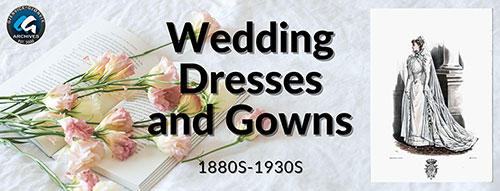
The ever-present wedding gown or wedding dress is a costume worn by the bride during the wedding ceremony. White wedding dresses were the most common during the 1880s through the 1930s and followed current fashions often by including decorative frills and lace.
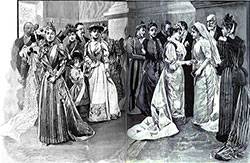
A Fashionable Wedding in Paris 1892
The large double page picture given this month represents an elegant French wedding. The bride is attired in flowing white robes, and the guests are all beautifully gowned. The husband is in evening dress. This is usual in Paris, although it looks out of place to English eyes.
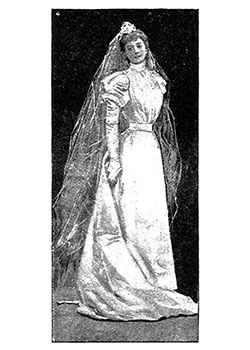
A Bride’s Moderate Trousseau in 1897
You have decided that you will be married in white satin. Then, too, you are to be, as the children say, “a real bride,” for you will wear a veil. The most becoming and the most suitable veil for a bride is that of tulle, which very full and reaches almost to the edge of the train in the back.
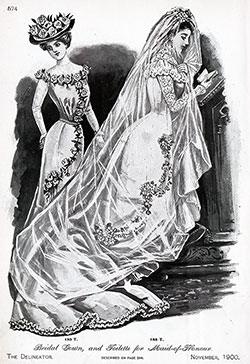
Bridal Gown & Maid-of-Honor Dress 188 T & 189 T - 1900
The luxurious fabrics associated in this gown, together with the perfect adjustment, make the mode one of spectacular beauty. Heavy white satin combined with all-over lace was used in the development, with ribbon, lace edging, chiffon ruchings and artistic arrangement of orange blossoms for garniture.
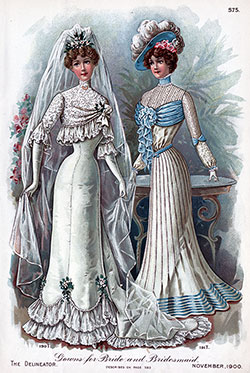
Brides and Bridesmaid Dresses 190 T & 191 T - 1900
A more elegant wedding gown could scarcely be desired than the one portrayed here, developed in ivory white satin and all-over lace. Frills of lace, white satin ribbon, and sprays of orange blossoms are employed as garniture. The dress shows the faultless adjustment which distinguishes the princess modes.
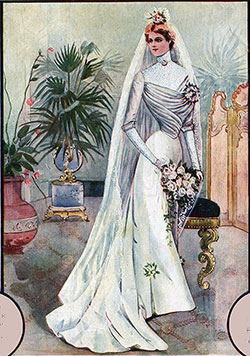
Charming Wedding Gown 4435 and 4436 - 1900
For the bride of the near future, a more charming wedding gown could not be desired than the one pictured here, developed in white satin Duchesse combined with all-over lace.
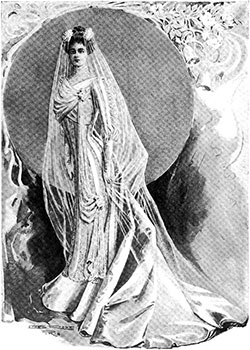
Fashions for Winter Brides - 1901
If “the entire world loves a lover,” certain it is, too, that all womanly women are interested in brides and trousseaux. The interest that is bestowed upon brides, in general, seems to be never failing. The trousseau of the present day is, however, a much more sensible affair than that of old.
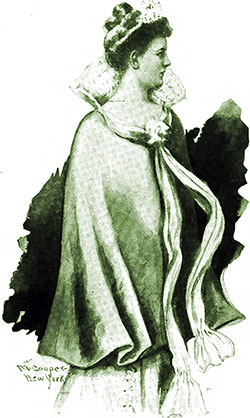
Queen Wilhelmina’s Trousseau - 1901
Few people outside of Paris, except country dressmakers and journalists, know what a “maison fermé’’ is in the dressmaking trade. Many journalists, representing papers from all over the world, have learned anew the full significance of the expression during the preparation of the Dutch Queen's trousseau in the Rue de Rivoli by Madame Nicaud.
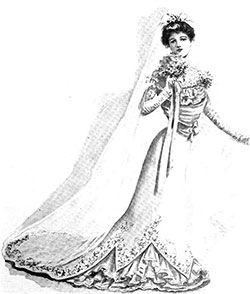
Spring Fashions for Bridal Gowns - 1901
Spring and Summer brides have more materials to choose from for their wedding gowns than the brides of the autumn and winter, and just now more materials are included in the category than ever before.
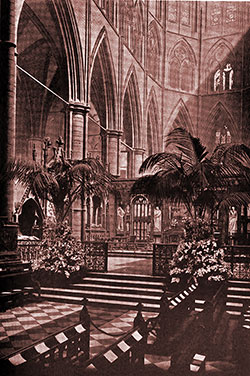
Church Decorations at Fashionable Weddings - 1902
The idea of turning fashionable London churches into a veritable forest of palms and flowers for lavish Society weddings is quite an innovation. While ten years ago, church decorations on such a scale were never thought of. It seems probable that today these decorations have reached their limit due to objections on the clergy's part.
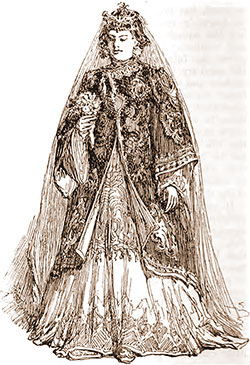
How Other People Marry in 1902
A glance at the marriage customs among other peoples and in other ages may cause the women of our favored land to feel that they, too, were "born in the most estimable place in all the world, and in the very nick of time, too."
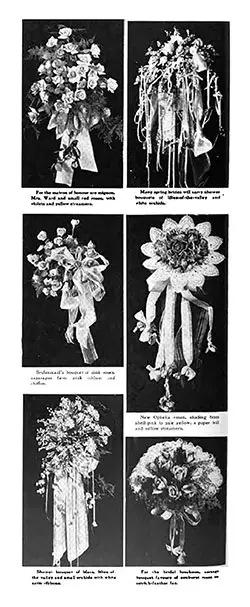
Advice for the Bridal Bouquet - 1910
The wedding bouquet, once considered indispensable, is now often replaced by a prayer book bound in ivory, white silk, or perhaps a piece of the material from which the wedding gown is fashioned. When the bouquet is carried, it should be enormous and tied with white ribbon, the ends of which fall far down upon the gown in front. Orange-blossoms are seldom made up into bouquets, lilies-of-the-valley, bride roses, orchids, white lilac, sweet peas, and chrysanthemums being the flowers most favored, or a combination of several of these is often employed.
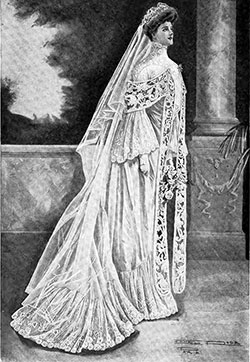
Advice For Bridal Gowns - 1910
There was a time when there were but two materials that were considered suitable for the wedding gown; namely, silk and satin. However, today the wedding dress may be selected from a variety of fabrics some of which are very inexpensive but none the less lovely and adaptable to the rather simple and graceful lines that characterize this gown.

Advice for the Bride’s Trousseau - 1910
It is understood of course that in every case the bride’s trousseau is given her by her parents, or by a very near relative of her own family, but she cannot with dignity accept such a gift from others, least of all from her betrothed or any member of his family.
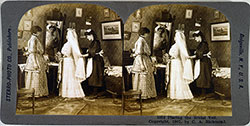
Advice for Bridal Veils - 1910
It is in this thing that the real art of draping the wedding veil lies, its security and its becomingness. The back view of a beautiful veil is hardly apt to be unbeautiful, no matter how unskilled the hands which put it on. It is the front view that determines the fitness of the draping to the features.
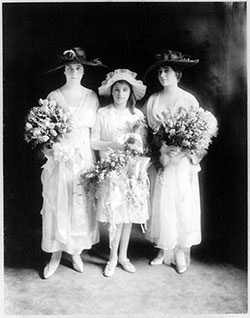
Advice for Bridesmaids’ Gowns and Accessories - 1910
Hardly less in importance to the question of the bride’s attire, no less certainly when the picturesque effect of the processional is considered, is the question of the bridesmaids’ gowns. For here selection must make or mar the picture.
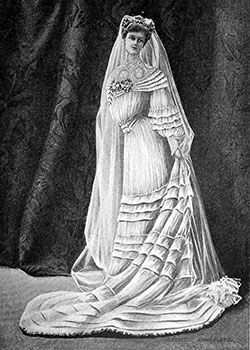
The Wedding Planner Poem - 1910
Deciding on your wedding day? Is June better than November? Here is a poem that describes the fortunes of those who marry during every month of the year.
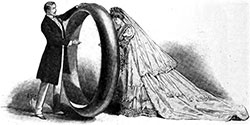
The Wedding Ring in 1912 by Filomena
As soon as Lent is ended, weddings are numerous. Apropos, then, Professor Pollard, lecturing the other day at University College, London, professed to find in the wedding-ring a time-honored symbol of woman's subjection.
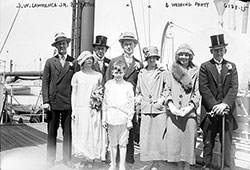
Advice on Ceremonial Traveling Gowns - 1910
The outfits at a quiet home wedding are less elaborate than they would be had the function a more imposing one. Frequently—and especially when no reception follows the ceremony—the bride is married in her going-away gown, which should in all cases be of inconspicuous color, though the manner of its making may be as stylish as one pleases.
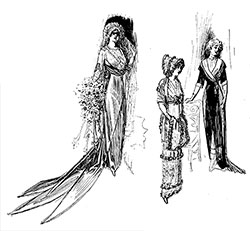
The Best Wedding Dress for the Venue - 1911
Trousseaux and wedding gowns, bridesmaids in open revolt over the cut of their dresses and the size of their hats, inconspicuous bridegrooms, and small flower-girls swelled with importance who fancy the whole wedding revolves around them— it is a busy month, isn't it?
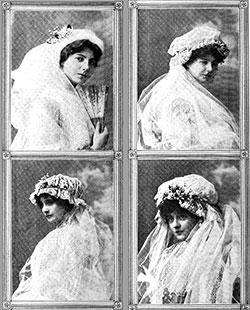
The girl who is obliged to consider expense very closely in the buying of her trousseau will probably deny herself the luxury of a wedding-veil, wearing a becoming bandeau of ribbon and orange blossoms instead.
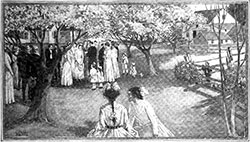
Two Weddings Cousin Lucy Saw 1911
A cute story about two weddings that took place during 1911. One taking place in South Africa, and the other an outdoor wedding in New England. Lucy describes the event and the apparel worn by the bridal parties at both weddings in this enjoyable short story.
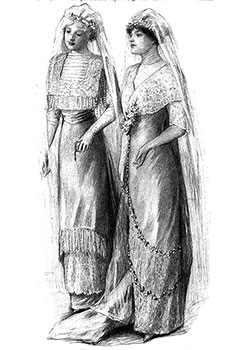
The new styles this year seem to be, by some kind fortune, especially appropriate for bridal attire. The bertha or fichu drapery of lace, which is so in vogue this year, is a particularly graceful finish for a wedding gown.
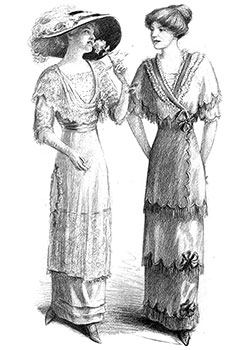
Bridesmaids' gowns during the past few years have become the means of communicating to the feminine world the latest dictates of fashion. The large coterie of friends of the bride nowadays displays the most kindly interest not alone in the bridal gown, which is of course of the utmost importance, but also in the frocks worn by her attendants.
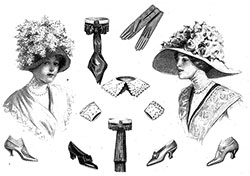
This spring's brides are rejoicing over the opportunity fashion has afforded them of being picturesque. Among their trousseau gowns, several charmingly feminine frocks may be included, which by their very quaintness lend the impression that the wearer has just stepped out of the frame of some old portrait of the 1830 period.
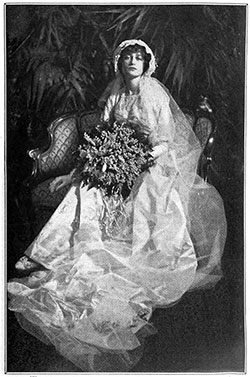
An Introduction and Study of Marriage Ceremonies - 1912
Although changes in wedding customs have gradually been brought about, the changes that are of greatest interest have occurred not because of new laws of etiquette and of dress, not by such trivial reasons as those in which dressmakers, florists, and caterers are concerned, but by more important conditions affecting the families of multimillionaires.
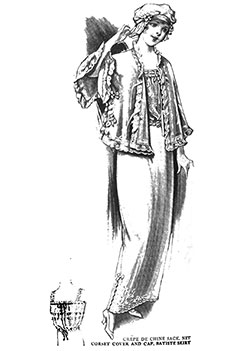
Dainty Suggestions in Bridal Lingerie – April 1914
As this issue of our magazine is primarily intended for the bride-to-be and her needs—elaborate or simple, whichever they may be—it seems most appropriate for me to offer on these pages suggestions for lingerie.
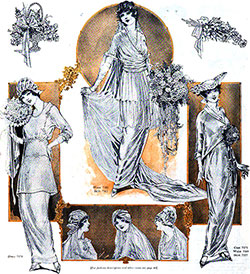
What the Bride of Today Will Wear - April 1914
Of all the costumes which are worn in one brief lifetime, the most sacredly alluring is that of the wedding hour. So long as the world moves there will be brides, and so long as there are brides there will be fashions.
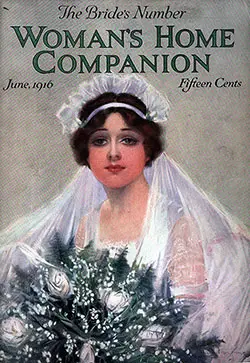
June Social Affairs for Brides of Yesterday, Today, and Tomorrow - 1916
AN old-fashioned "high tea" served as a buffet supper, is likely to enable the hostess to ask all the friends of the honored couple. The whole idea is to reproduce as nearly as you can the atmosphere and customs of fifty years ago.
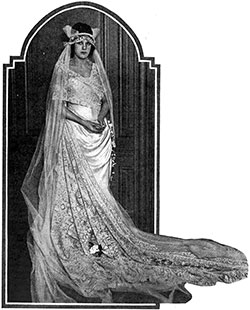
The Intriguing Charm of Rare Wedding Laces - 1921
The wedding laces, particularly the veil, may be said to perpetuate the romance interest and a refining element in esthetic taste to a point above that of any handiwork within world history, the veil perhaps best illustrating the imaginative appeal of the gossamer filaments of this art of fairy-fingers.
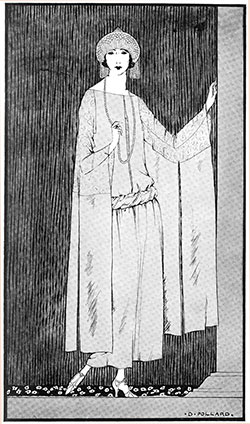
Fashion For Brides of All Ages - 1922
The Wedding-Dress Should, Above All, Be Seasonable ~ Suited to the April Freshness of Its Wearer Or to the Riper Grace of Her September Maturity.
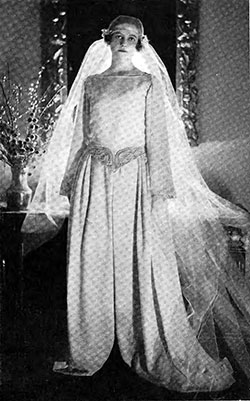
Paris Costumes the Brides with Originality - 1922
In these wedding costumes, one notes a new tendency in the coiffure, a tendency to shape the familiar crown of orange-blossoms into a diadem, not a mere fillet of flowers, such as has been seen before, but a true diadem of the very shape of those diadems of brilliants made by Cartier or Chaumet, which these brides will wear a few weeks after their weddings.
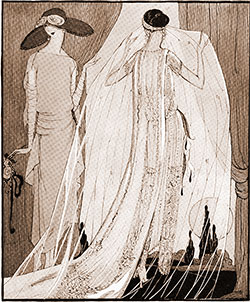
Spring and Summer Satin Wedding Gowns - 1922
Simplicity and Charm Are the Characteristics of These Satin Wedding Gowns Which Are Quickly Available and Moderately Priced.
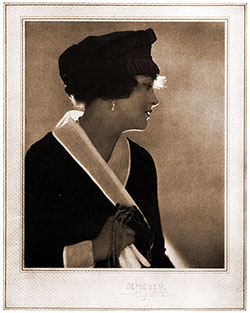
From the Trousseau of Mrs. Cromwell Brooks 1922
Mrs. Douglas MacArthur, Formerly Mrs. Cromwell Brooks (Neé Louise Stotesbury), Is the Only Daughter of Mrs. Edward T. Stotesbury of Philadelphia. Her Recent Marriage To Brigadier-General Douglas MacArthur, the Commandant of the United States Military Academy at West Point, Was an Event of Unusual Interest.
